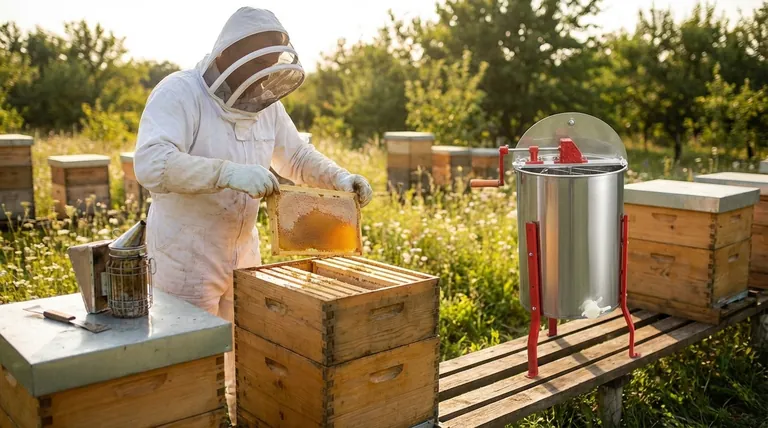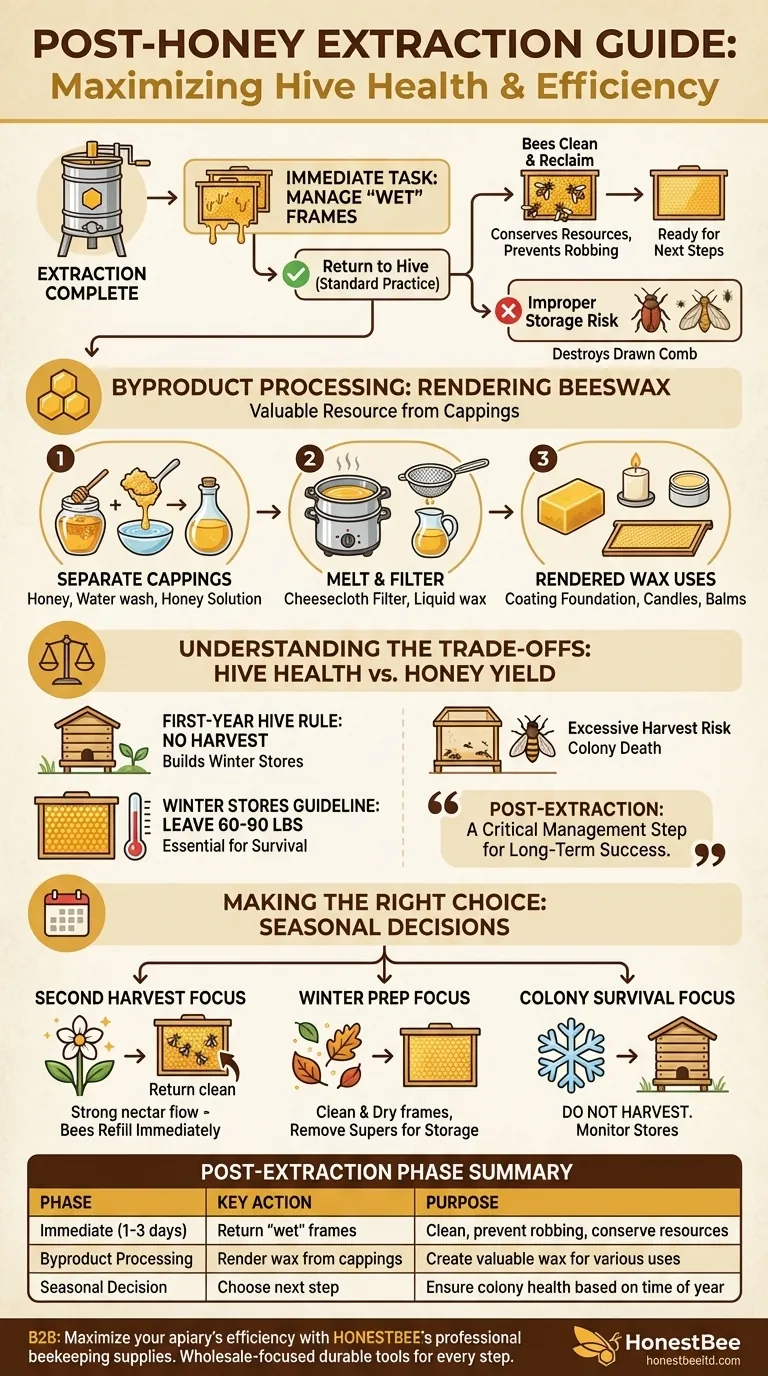Immediately after honey extraction, the "wet" frames, still coated in a thin layer of honey, are returned to the hive. This allows the bees to clean the frames and reclaim the residual honey. Depending on the time of year, this either prepares the frames for the next round of honey storage or readies them for winter storage.
The post-extraction phase is not merely about cleanup. It is a critical management step that directly impacts hive health, resource efficiency, and your colony's readiness for either continued production or winter survival.

The Immediate Task: Managing "Wet" Supers
Your first job after bringing your extraction equipment inside is to deal with the now-empty, but still sticky, honey frames and supers.
What Are "Wet" Frames?
"Wet" frames are the combs you have just run through an extractor. While the bulk of the honey is gone, a residual film remains, making them sticky and a powerful attractant to bees and other pests.
Why Return Frames to the Hive?
Returning these frames to the original hive is standard practice for several reasons. First, the bees will meticulously clean every last bit of honey, ensuring no resource is wasted. This also provides them with a small, immediate food boost.
Second, it prevents a phenomenon known as robbing, where bees from other hives (or your own) discover an easy food source and descend upon it in a frenzy. Leaving wet frames out in the open can trigger this dangerous behavior.
Finally, clean frames give the bees a head start. They do not have to expend energy building new wax, allowing them to begin refilling the cells immediately if a nectar flow is still active.
The Correct Procedure
Place the super containing the wet frames back on top of the hive, typically above the inner cover. The bees will move up, clean the frames completely within a few days, and move the reclaimed honey down into the main hive body.
Processing the Byproducts: Rendering Beeswax
While the bees clean the frames, you can process the wax cappings that were sliced off the combs. This is a valuable byproduct of the harvest.
Separating Honey from Wax Cappings
The cappings are a mixture of beeswax and a significant amount of honey. To separate them, you can gently wash the cappings in cool water. The honey will dissolve into the water (creating a honey-water solution you can use), leaving you with clean wax.
Melting and Filtering the Wax
The cleaned wax can be melted using a double boiler or a dedicated wax melter. Never heat wax over a direct flame, as it is flammable.
Once melted, pour the liquid wax through a filter like cheesecloth to remove any hive debris or impurities. The filtered wax can then be poured into molds to cool and harden into clean beeswax blocks.
Common Uses for Rendered Beeswax
This rendered beeswax is a versatile resource. Beekeepers often use it to coat new plastic foundation or frames, encouraging the bees to accept and build on them. It can also be sold or used for making candles, balms, and cosmetics.
Understanding the Trade-offs: Hive Health vs. Honey Yield
Responsible beekeeping requires balancing your desire for honey with the needs of the colony. The post-harvest period highlights this dynamic perfectly.
The First-Year Hive Rule
For any hive in its first year, you should not harvest any honey. The colony needs all of its resources to build up its population and, most importantly, create enough winter stores to survive its first cold season.
Calculating Winter Stores
Even for established hives, you must never take all the honey. A colony needs a substantial amount of honey to feed on from late fall to early spring. The exact amount varies by climate, but leaving 60-90 pounds (27-41 kg) of honey is a common guideline for colder regions. Harvesting too much is a primary cause of colony death over winter.
The Risk of Improper Storage
If you choose not to have the bees clean the frames and instead store them wet, you must do so in airtight containers or bags. Failure to seal them properly will inevitably attract wax moths and other pests, which can destroy your drawn-out comb—a hugely valuable resource for the hive.
Making the Right Choice for Your Goal
After the bees have cleaned the frames (usually within 2-3 days), your next step depends entirely on the calendar and local conditions.
- If your primary focus is a second harvest: Return the cleaned frames to the hive immediately, as the bees will begin refilling them as long as a strong nectar flow continues.
- If your primary focus is winter preparation: Return frames for cleanup, then remove the now-clean and dry supers from the hive for storage. This prevents the bees from creating a small, difficult-to-defend honey patch high up in the hive.
- If your primary focus is colony survival (first-year hives): Do not harvest at all. Your entire focus is monitoring their stores and ensuring they are strong enough for winter.
Properly managing the post-harvest phase ensures the long-term health and productivity of your colony.
Summary Table:
| Post-Extraction Phase | Key Action | Purpose |
|---|---|---|
| Immediate (1-3 days) | Return 'wet' frames to the hive | Let bees clean residual honey, prevent robbing, and conserve resources |
| Byproduct Processing | Render beeswax from cappings | Create valuable wax for foundation, candles, or balms |
| Seasonal Decision | Choose to prepare for winter or a second harvest | Ensure colony health and maximize productivity based on time of year |
Maximize your apiary's efficiency with HONESTBEE's professional beekeeping supplies. Whether you manage commercial apiaries or distribute beekeeping equipment, our wholesale-focused operations provide the durable, high-quality tools you need for every step of the honey production process—from extraction to hive health management. Contact our team today to discuss your specific needs and discover how we can support your beekeeping success.
Visual Guide

Related Products
- Stainless Steel 3 Frame Manual Honey Extractor Spinner for Bee Honey Extraction
- Plastic Hand Crank 2 Frame Honey Extractor Low Price
- electric honey extractor honey centrifuge 3 frame honey extractor stainless steel honey frame extractor
- 6 Frame Manual Stainless Steel Honey Extractor Beekeeping Equipment
- HONESTBEE 3-Frame Manual Acrylic Honey Extractor
People Also Ask
- What happens to wired frames after honey extraction? Maximize Apiary Efficiency & Bee Health
- What are the differences between manual and electric honey extractors? A Beekeeper's Guide to Power, Speed & Cost
- Which type of honey extractor is generally more durable? Focus on Material & Build Quality for Longevity
- How do you manually extract honey? Choose the Best Method for Your Hive
- How to extract honey by hand? A Guide to Crush & Strain vs. Manual Extractors



















